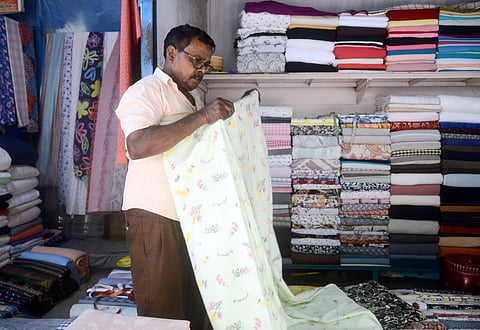

The sun in Chennai does not merely shine — it gradually starts asserting dominance. In the morning, its rays gently prod the skin as a prelude to the heat that grows to be unstoppable by noon. By afternoon, a fleeting breeze offers brief respite, only to be replaced by a humid cloak enveloping the rest of the day. Yet, for the vendors of Pantheon Road (Cotton Street), this relentless cycle is a routine. Their response: “Athu enna? Summer avlo thaane?” Their daily toil under the unforgiving sun mirrors the broader struggles of the working class — persistent but often invisible in the city’s wider narrative.
Here on Cotton Street — a narrow, densely packed strip of authorised street vendors in central Chennai — bolts of fabric and routines of commerce mask deeper stories: of inherited labour, quiet ambition, and a total absence of women in public-facing roles.
No place for women
Cotton dominates the visuals. Neatly arranged fabrics stretch in orderly stacks, from plain weaves to intricate patterns — checks, stripes, florals — in every shade, from deep blues to soft pastels. Synthetic blends, linens, and silks are sorted with care. Scarves sway as ends tether to rods; shirts and trousers rest in tall piles. The uniformity reflects discipline built over years.
But amid all this fabric, something is missing. Not a single stall on Cotton Street is run by a woman. The absence is striking, and reluctantly accepted. “Veyil romba jasthi. Ladies-ku kashtam (The heat is too much; it’s hard for women),” says one vendor. “There’s no toilet or security,” another adds. “Showroom is fine, but this is a road,” someone shrugs. Pushed further, and the answers fade into silence.
Inside a textile shop, slightly removed from the street, a woman works at the billing counter. But when approached, she refuses to speak. The male shop owner offers a few polite lines about stock and business — nothing about the near-total invisibility of women in this trade.
Inheriting a livelihood
For most vendors, this is not just a job — it’s a legacy. Trade on Cotton Street flows through family lines, but rarely across gender. Saravanan, who has worked on Cotton Street for eight years, entered the trade through his father. “My dad used to do thuni (cloth) business. After finishing my degree, I joined Cotton Street.” His mother runs a boutique. His brother is in the business too. But when asked about sisters or female cousins entering the trade, he asserts: “Ladies haven’t worked here.”
Prabhu, folding fabric outside his chittappa’s kadai for the last three years, recalls weekends when crowds pour in. “Romba busy — Saturday, Sunday the streets would be crowded. People from all age groups would come. School pasanga, old people, everyone.” His stock includes export surplus from Surat and Kolkata, sometimes blends from Guduvancherry. Tailors, designers, even actors stop by to buy.
Behind the display
Despite the colour and commerce, the work is tough and comforts a few. There are no public toilets. Some stalls don’t even have a fan. “We we experience searing headache and dizziness. But this is normal for us now,” says Prabhu. They fold, sell, endure — always in still, hot air.
The earnings vary. “Some days, we get Rs 600. For food, another expenses, Rs 100 is gone. If lucky, we would make Rs 1,200,” Prabhu says. Most vendors are part of Pantheon Thozhilar Sangam, a loosely structured union that has existed for decades. “We (the ones who don’t own a store yet) get paid through the owners. If we have issues, we approach the Sangam,” shares Prabhu. There is a fixed rent for the stalls that they pay to the government, `100 every month through DD. There is also the unavoidable negotiation — with heat, customers and stall owners.
And yet, ambition persists — quiet, but steady. Saravanan dreams of going beyond his street stall. “I want to buy a shop like this. I want something of my own.” Others take pride in who comes to buy. Mathiyazhagan lights up while stating that his shop is preferred by the people from the film industry and political circles. Sampathkumar, a veteran of the street for over four decades, remembers its beginnings: “First there was palaka (a wooden slab). Then only four stalls. Now 77 stalls. There is a lot of improvement.” His goods come from Royapuram, Erode, Jaipur, Ahmedabad — a circuit built over years, sustained by trust. “High-class customers will come, those who purchase from the car. But all that is mostly on weekends,” he says bluntly. The customers’ experience of running their hands on the fabrics, testing the quality, and fully convincing themselves before choosing, makes it wholesome; one that is probably lost with the advent of purchasing by just a click.
Even in an era of online marketplaces and climate strain, Cotton Street takes up its own significance powered by human connection. The fabric sold here is only half the story. The rest — the heat, the labour — is not displayed, but worn by the sellers.